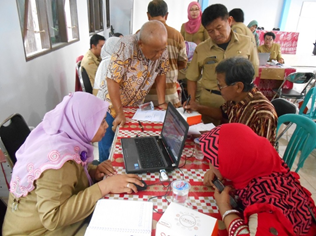Organization
City of Surabaya
Type of experience
participatory planning
consultation, vote, referendums
e-government, open government
Theme
urban planning
local development
SDGs
SDG 9
SDG 11
Award

11th.
Optimizing E-MUSRENBANG for participatory planning for development. The national system of planning for development has a Musrenbang forum that enables citizen participation through the presentation of proposals of different scales and territorial proximity. The facilitators contribute to geolocalize the demands.
Objectives
The purpose of this online application development is to facilitate the supervision or monitoring. With open access to the widest appropriate authority, surveillance can be done not only by the competent authority, but also by all employees and the community who are willing to take time to assist the monitoring process. In addition to this application, opened channels to lodge complaints and suggestions were also provided which will be responded by Bappeko and may result in a healthy dialectic process.
Utilization of progress and evaluation using e-musrenbang system is done through a coordination mechanism between Bappeko with each village / district and technical SKPD (Government Units and Agencies).
Participants
1. RW proposal stage, followed by representatives from RW to make entry proposal to be sent to the village. The number of participants of representatives RW who take part, ± 5 people.
2. Village proposal stage, made by the village (village chief or his related staff) and some representatives are within RW authority. The number of participants of representatives who take part, ± 25 people.
3. Verification Phase, followed by representatives from RW, Village, Bappeko and some representatives of SKPD related directly to development work in the community. The number of participants is around 50-75 people.
Description
Context
Based on Regulation by Minister of Home Affair No. 54 of 2010 about the Implementation of Government Regulations No. 8 of 2008 about Stages, Preparation Procedures, Control, and Evaluation of the Implementation of Regional Development Plans and supported by Law No. 25 of 2004 about National Development Planning System. Development Planning Forum or unanonimously known as Musrenbang in Indonesia is one of the stages in development planning which involve society and people at large or also known as participative planning and development. The involvement of the people iduring this process is done through the submission of development proposal which started in the entry level forum namely Neighborhood Unit (RT) and Community Unit (RW) to the city level.
In 2009 the initiative to create e-musrenbang application system has emerged, where the proposed development of society is no longer done manually but facilitated by the application system. There are changes in the submission of musrenbang proposal from manual to online which results in a transformation in the administration system, change of organizational and administrative culture, and reformation towards a more worthy, easier and more transparent government service procedures. Transparency has become people's demand to be able to monitor the proposal that has been presented in musrenbang and was answered through the application system.
Experience
Filing people aspirations of the development planning from the local level up to the districts until 2008 were presented in the form of hard copy / print. If there were changes in the proposed development, reprinting it would be required, so it creates inefficiencies in both costs and time, and if citizens are asking the status of the proposal then the answer would be difficult to be given quickly and directly because they must track the proposal files and the results of the verification that has been done by SKPD.
The documents submission pattern in a form of hard copy caused several problems including:
- Proposal priority stipulation. It is necessary to prioritize the proposals because not every proposal submitted by society could be accommodated or realized due to limited budget.
- Conformity between proposals and program plans. Manual musrenbang recapitulation and implementation allowed unconformity between development planning proposals and program and activity plans that had been set forth by the government. This occured because the proposal had not yet been listed with set prices agreed by the government and thus led to inaccuracy in budget target;
- Controlling or monitoring. Both the government and the society had difficulty in controlling or monitoring the proposal process because proposal recapitulation result was not outlined in a document or an application that can be viewed real time.
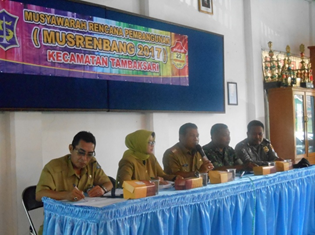
The creativities made by Surabaya City Government in the website www.musrenbang.surabaya.go.id include :
- It becomes possible to determine maximum priority budget in urban village level based on the number of neighborhoods, number of community units, total area as well as the number of poor families. This maximum priority budget will automatically limit the number of proposal intake since they couldn’t exceed the ceiling budget. Therefore, the development in Surabaya could be evenly distributed in all areas and has been through society discussions and considerations.
- It becomes possible to prioritize the proposals as per their urgency, availability and magnitude impact on the society.
- It becomes possible to facilitate the reserved proposals as replacements if they have some weight in them.
- The application could show the detail of development proposals accompanied with some photos of the accurate location based on survey conducted.
- It could display the point of the proposed development location in spatial-based map by making the use of Geographic Information System (GIS).
- It becomes possible to verify the development proposals in parallel between technical working units realizing the proposals and Development Planning Board as the development planner.
- It could facilitate alternative proposals as a replacement if there is a proposal that otherwise does not pass the verification.
- It could print the meeting minutes with a specific format that has been adapted to the prevailing regulations. The meeting minutes are also signed by representatives of the community and City Government authorities so that the proposals accountability in the application can be maintained.
- Society can give a rating for the proposals in accordance with the area in which they live by providing like or unlike on the proposal through login by using identity card numbers. The rating could support the society point of view toward public affairs, that are Surabaya development in general as well as musrenbang proposal realization.
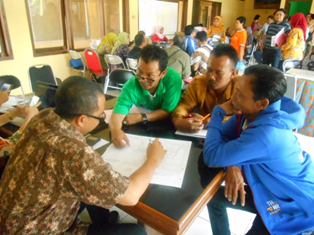
Leadership and shared responsibilities
- Development Planning Board as implementing regional working unit which have roles in holding city musrenbang and providing the system as well as other data.
- Sub-districts and urban villages, which have role in validating the proposals as well as the closest officials to the community.
- Regional working units, as the verifiers of development activity implementation of the City Government and also as executors of the proposals from the community;
- The community as the proposers that are represented by neighborhood and community units.
- Surabaya City Council as the observer of musrenbang implementation.
Methodology
- Develop e-musrenbang application continuously. This process is done by taking into account of musrenbang implementation mechanism as per the prevailing regulations.
- Create the dictionary about the proposed activities which has been adjusted with standard unit price thus the community proposals and the development programs by Surabaya City Government could be synchronized. Therefore, it could improve government responsiveness toward citizen’s demand and needs.
- Make an online guideline for musrenbang procedure.
- Install internet connection in all community units throughout Surabaya as much as 1.721 points to facilitate community to access musrenbang website;
- Optimize the function of Broadband Learning Centers (BLC) which spread in strategic locations in Surabaya as a learning center of IT-based participatory planning process.
- Coordinate with other regional working units, sub-districts and urban villages about musrenbang implementation.
- Socialize and provide technical assistance on musrenbang to regional working units as well as the community;
- Held meeting forum among regional working units and the community. This forum aims to obtain mutual agreement regarding type, location, and the volume of the proposals thus it demonstrates transparency through public consultation mechanism.
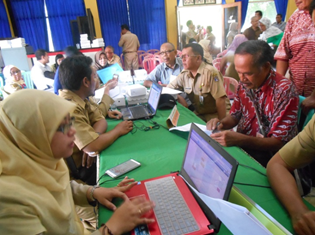
Description of the information disseminated during the process
The information conveyed to the public are:
- Musrenbang is an open forum to identify and prioritize community development policies in order to achieve mutual agreement regarding development priorities and their budgets.
- Musrenbang can be an effective means to engage citizens in local development planning.
- Musrenbang serves to synchronize planning of 'bottom-up' and 'top down' in regional development.
In E musrenbang there are 2 steps of login, the first one is the apparatus of the governments login, among others, RW team, Village, District, Region, and Bappeko. The second login is Surabaya residents by indicating the name and identification number, and identify themselves as citizens of Surabaya validated by e-KTP.
In E musrenbang, there are guide manuals / filling procedures and the number of proposals that are categorized as RW proposals and the community proposals. Until now there are 1743 of RW proposals and 827 community proposals, other proposals were processed by (SKPD) with a total number of 2167 proposals. List of proposals can be seen in detail by district names in which there are many RW proposals and community proposals. The list of proposals based on existing community districts allow the districts to monitor the proposals.
Feed-back to the participants
The target groups facilitated by e-musrenbang application system are as follows:
- The society submitting their proposals.
- Surabaya City Government officials.
- Surabaya citizens in general.
The benefits obtained by Bappeko as the institution that accommodate the proposals and the society as the participants are:
- More data accuracy on the proposals (the data namely location, type, volume, budget and the proposer are more accurate)
- It could simplify work type grouping on the proposals.
- Faster data processing and efficient time management due to the change in administrative process from manual to system. Hence, the new system has cut some unnecessary costs compared to the previous one.
- People could easily validate whether their proposals have been verified by musrenbang team or not, completed with the photos of their proposals.
- Development Planning Board or Surabaya City Government is able to estimate the budgetary needs of the proposed activity in the proposals quickly through the application.
- All Surabaya citizens could participate by giving their opinions and comments on each proposal.
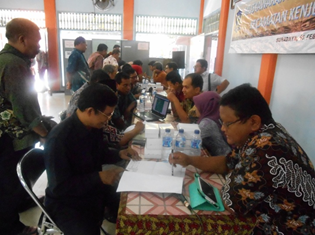
Highlights of the experience
The main highlights of e-musrenbang implementation are among others:
- The implementation of participatory development planning so that people can contribute directly to the development planning process;
- The development implemented by the Surabaya City Government has been right on target so that the budget allocated by the government of Surabaya is not wasted and can be useful for the development of society, both the physical and non-physical;
- The development activities undertaken by the government of Surabaya can be controlled by the people because they themselves know exactly the location and volume of development activity.
 11th.
11th.




